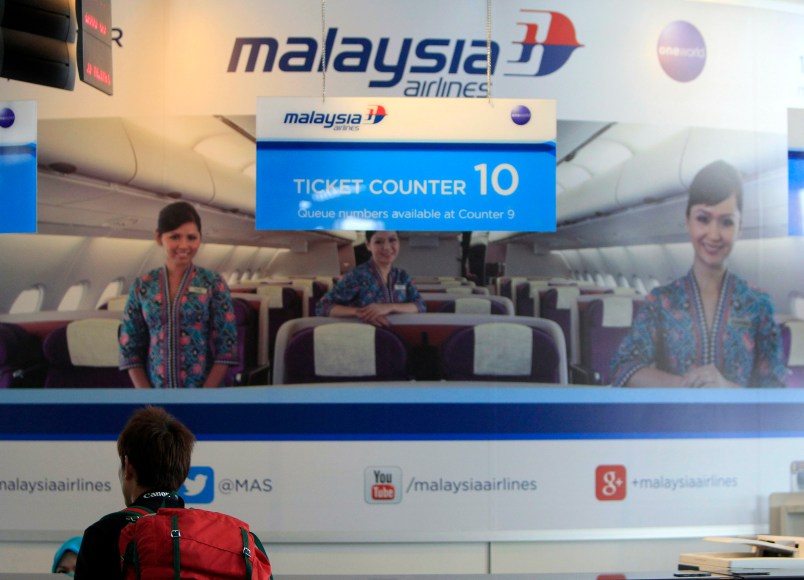KUALA LUMPUR, Malaysia (AP) — Piracy and pilot suicide are among the scenarios under study as investigatorsgrow increasingly certain the missing Malaysian Airlines jet reversed course and headed west after its last radio contact with air traffic controllers.
The latest evidence suggests the plane didn’t experience a catastrophic incident over the South China Sea as was initially suspected. Some experts theorize that one of the pilots, or someone else with flying experience, hijacked the plane or committed suicide by plunging the jet into the sea.
A U.S. official said Friday in Washington that investigators are examining the possibility of “human intervention” in the plane’s disappearance, adding it may have been “an act of piracy.” The official, who wasn’t authorized to talk to the media and spoke on condition of anonymity, said it also was possible the plane may have landed somewhere.
While other theories are still being examined, the official said key evidence suggesting human intervention is that contact with the Boeing 777’s transponder stopped about a dozen minutes before a messaging system on the jet quit. Such a gap would be unlikely in the case of an in-flight catastrophe.
A Malaysian official, who also declined to be identified because he is not authorized to brief the media, said only a skilled aviator could navigate the plane the way it was flown after its last confirmed location over the South China Sea. The official said it had been established with a “more than 50 percent” degree of certainty that military radar had picked up the missing plane after it dropped off civilian radar.
Malaysia’s acting transport minister, Hishammuddin Hussein, said the country had yet to determine what happened to the plane after it ceased communicating with ground control around 40 minutes into the flight to Beijing on March 8 with 239 people aboard.
He said investigators were still trying to establish with certainty that military radar records of a blip moving west across the Malay Peninsula into the Strait of Malacca showed Flight MH370.
“I will be the most happiest person if we can actually confirm that it is the MH370, then we can move all (search) assets from the South China Sea to the Strait of Malacca,” he told reporters. Until then, he said, the international search effort would continue expanding east and west from the plane’s last confirmed location.
On Thursday, a U.S. official said the plane remained airborne after losing contact with air traffic control, sending a signal to establish contact with a satellite.
Boeing offers a satellite service that can receive a stream of data on how an aircraft is functioning in flight and relay the information to the plane’s home base. Malaysia Airlines didn’t subscribe to that service, but the plane still had the capability to connect with the satellite and was automatically sending signals, or pings, said the U.S.official, who spoke on condition of anonymity because he wasn’t authorized to discuss the situation by name.
Scores of aircraft and ships from 12 countries are involved in the search, which reaches into the eastern stretches of the South China Sea and on the western side of the Malay Peninsula, northwest into the Andaman Sea and the Indian Ocean.
India said it was using heat sensors on flights over hundreds of Andaman Sea islands Friday and would expand the search for the missing jet farther west into the Bay of Bengal, more than 1,600 kilometers (about 1,000 miles) to the west of the plane’s last known position.
A team of five U.S. officials with air traffic control and radar expertise — three from the U.S. National Transportation Safety Board and two from the Federal Aviation Administration — has been in Kuala Lumpur since Monday to assist with the investigation.
White House spokesman Jay Carney sidestepped questions Friday about the possibility of human intervention in the plane disappearance, saying only that U.S. officials were assisting in the investigation.
“I don’t have conclusive answers and I don’t think anyone does,” Carney said.
Malaysia has faced accusations it isn’t sharing all its information or suspicions about the plane’s final movements. It insists it is being open, and says it would be irresponsible to narrow the focus of the search until there is undeniable evidence of the plane’s flight path.
At this point, there is no evidence of any wrongdoing on the part of the two pilots, though Malaysian police have said they are looking at their psychological background, their family life and connections.
Zaharie Ahmad Shah, 53, and Fariq Abdul Hamid, 27, have both been described as respectable, community-minded men.
Zaharie joined Malaysia Airlines in 1981 and had more than 18,000 hours of experience. His Facebook page showed an aviation enthusiast who flew remote-controlled aircraft, posting pictures of his collection, which included a lightweight twin-engine helicopter and an amphibious aircraft.
Fariq was contemplating marriage after having just graduated to the cockpit of a Boeing 777. He has drawn the greatest scrutiny after the revelation that in 2011, he and another pilot invited two women boarding their aircraft to sit in the cockpit for a flight from Phuket, Thailand, to Kuala Lumpur.
Mike Glynn, a committee member of the Australian and International Pilots Association, said he considers pilot suicide to be the most likely explanation for the disappearance, as was suspected in a SilkAir crash during a flight from Singapore to Jakarta in 1997 and an EgyptAir flight in 1999.
“A pilot rather than a hijacker is more likely to be able to switch off the communications equipment,” Glynn said. “The last thing that I, as a pilot, want is suspicion to fall on the crew, but it’s happened twice before.”
Glynn said a pilot may have sought to fly the plane into the Indian Ocean to reduce the chances of recovering data recorders, and to conceal the cause of the disaster.
___
Lowy reported from Washington. Associated Press writers Ashok Sharma in New Delhi, Jim Gomez in Kuala Lumpur, and Rod McGuirk in Canberra, Australia, contributed to this report.
Copyright 2014 The Associated Press. All rights reserved. This material may not be published, broadcast, rewritten or redistributed.









